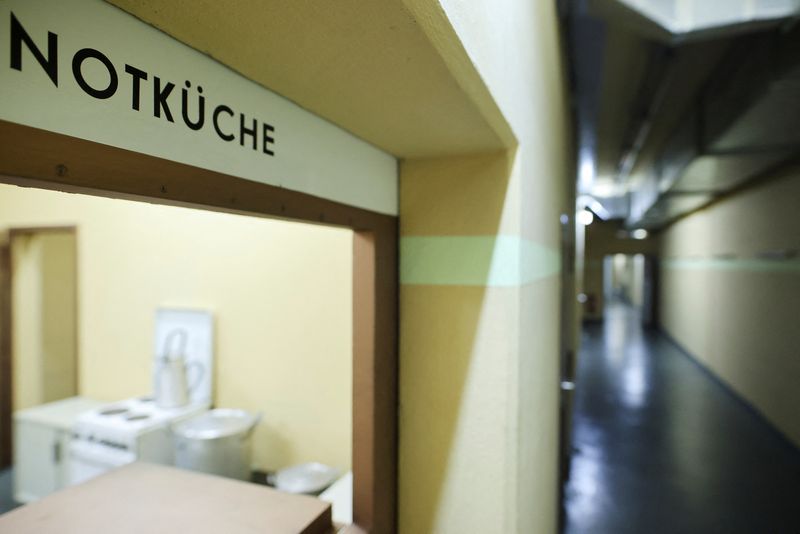Russian nuclear rhetoric rekindles German Cold War fears
2022.10.27 05:27
[ad_1]
5/5

© Reuters. The door of an emergency kitchen is seen in a former ciliv defence shelter, wich provided protection for people for two weeks after a nuclear attack and is nowadays used as a Cold War documentation centre, inside an underground station in Cologne, Germany
2/5
By Tom Sims
COLOGNE, Germany (Reuters) – Deep inside a decommissioned nuclear bunker built into a Cologne subway station at the height of the Cold War, tour guide Robert Schwienbacher says he is getting a number of inquiries from Germans asking for space available in an emergency.
Concerns of Germans that dissipated with the fall of the Berlin Wall are now creeping back after decades of peace. It is a flashback for a nation that found itself at the geographic and political centre of the Cold War.
President Vladimir Putin has in recent months escalated his “special military operation” in Ukraine, calling up reservists and threatening to use nuclear weapons to defend Russian land, while U.S. President Joe Biden has talked of “Armageddon”.
“No one should use nuclear weapons,” German Chancellor Olaf Scholz warned earlier this month.
Days later, a survey by insurer R+V found that 42% of Germans now fear a war with German participation, up from 16% last year, the biggest jump since the Kosovo War in 1999.
With the Ukraine border less than a nine-hour drive from Berlin, war feels uncomfortably close for many, though there is no imminent threat on domestic soil.
The Russia-Ukraine conflict has nevertheless prompted a rethink in a nation that was a primary beneficiary of the thaw between East and West after the fall of Communism more than 30 years ago.
Schwienbacher said requests for bunker space, either by email or verbally, during every tour he gives, only started since the war and are giving him a reason to reflect.
“I am only human and also worry that it could get worse,” Schwienbacher said.
“Germany is a flashpoint in Europe,” he said under the hum of fluorescent lights in the dim bunker.
(GRAPHIC: War fears in Germany –
Lars Pohlmeier, a German medical doctor, once detained behind the Iron Curtain as a teen, said he is relieved his 15-year-old son is heading to Canada for studies.
“If I have ever had the feeling that we are at the brink of annihilation, that would be now,” he said.
The former West Germany built 2,000 public bunker-like “protection spaces” from the mid-1960s. In 2007, the government of a unified Germany decided to wind them down.
But the conflict in Ukraine has prompted Germany to hold on to the remaining 599 and its Federal Real Estate Agency is in the process of surveying them for possible upgrades.
Meanwhile, demand for private bunkers has soared.
Berlin-based BSSD, which installs such units, has seen a jump of at least 300% in orders this year from previous years, spokesperson Mark Schmiechen said.
“A change has taken place. Before we were seen as freaky outsiders,” Schmiechen said. “Today we are hip.”
On the eve of German reunification in October 1990, then Chancellor Helmut Kohl thanked Russia’s Mikhail Gorbachev for the thaw that led to a united Germany, saying that the era which preceded it should never be repeated or forgotten.
Felix Ludwig, who was born that year, curates a museum at a former East-West motorway checkpoint in Marienborn, where some people died as they tried to flee East Germany.
“One has the impression that the fear of a World War Three is growing,” Ludwig said.
While some Germans are nervous, not everyone fears another Cold War.
Stuttgart mayor Frank Nopper grew up next to neighbours who bought a vacation home in Spain to flee any hostilities in Germany during the Cold War. He said his city feels closer than many German municipalities to the Ukraine war because his region is home to two U.S. military command centres.
“Although many people are worried and unsettled these days, they do not feel any immediate threat – at least not yet,” he said.
Anxiety in Europe’s largest economy is heightened by double-digit inflation, and concerns about energy shortages after years of heavy reliance upon Russia for fossil fuels.
Eva Weber, mayor of the Bavarian city of Augsburg, said this month she is preparing for various crisis scenarios that include electricity and heating cuts, an exercise that is playing out in towns throughout Germany.
On Dec. 8 at 11 a.m., all of Germany’s sirens will sound in a test, in a second-ever “warning day”, and in a first, text messages will also be sent to all mobile phones.
Towns near U.S. military bases are particularly on edge.
The mayor of Kaiserslautern, home to the U.S. base Ramstein, said Russia’s nuclear rhetoric is designed to stir up fears in the West to erode support for Ukraine.
“It is only understandable that fears are making a comeback,” said the mayor, Klaus Weichel.
Peter Degenhardt, mayor of neighbouring Landstuhl, said he and his constituents fear a “hybrid war”.
Cologne was flattened in World War Two through hundreds of air raids, although its famous cathedral remained standing.
In 1979, the city built its now decommissioned bunker into the Kalk Post metro station. Above is a lively neighbourhood of Turkish travel agencies, barbers and restaurants. Below is a space designed for 2,366 people to survive for exactly 14 days.
Schwienbacher said temperatures would quickly rise to 37 degrees Celsius in close quarters, with no showers and small boxes of provisions that should be eaten over two days.
“It was built more to calm the people than protect them,” Schwienbacher said.
In one of several emails sent to Schwienbacher and seen by Reuters, a person asks: “Are these bunkers still operational for us in the event of a possible war?”
After 14 days, diesel, water and other supplies would run out and, Schwienbacher said, people would be forced to exit, “no matter what it looks like outside”.
[ad_2]
Source link








